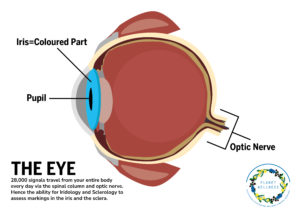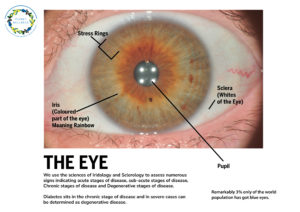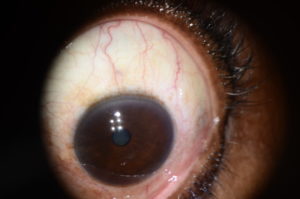What Does Your Iris Say About Your Health?

The Iris is the coloured part of your eye. Iris is a name derived from Greek Mythology meaning “Goddess of the rainbow”. The Iris comes in various colours and the most popular colours are blue, green, light brown and dark brown. The Iris controls the diameter of your pupil. The pupil determines how much light reaches the retina. The Iris is a kaleidoscope of patterns and colours. The three most common iris patterns are furrows, crypts and pigmented rings.
The patterns in your Iris are a more accurate identifier than your fingerprints. This is because the patterns in the Iris are very intricate and unique. This is the reason some places have started using iris scans as a means of identifying individuals. This is more reliable as fingerprints can be affected by damages on your skin and fingers, such as from cuts and scars. When you look closely at the Iris, you will see different patterns such as rings and furrows inside it. It is more difficult to see these with the naked eye in darker coloured irises. This is why Iridologists, Doctors and Opticians use a light and magnifying glass or special Iridology cameras.

Pigmented rings are wide coloured bands around the pupil that are a different shade than the rest of your Iris. These are also known as Contraction Furrows or Stress rings. It indicates the level of stress of various organs. One ring signifies 20% stress.
Crypts are tiny diamon-shaped holes in the Iris that can range in size. These also indicate weaknesses is specific organs and parts of the body.
Iridology is the study of the patterns and colours on the iris of the eye. This enables a person’s overall health condition to be determined. It is a non-invasive method of viewing the iris to determine existing or potential health issues. Iridologists use iridology charts to make these observations. The charts have been created after observation of a variety of irises over the years. Each marking and zone in the iris represents a different aspect or organ of the human body.
In the 1890s, the Hungarian physician Ignatz Peczely invented Iridology. It is thought the Iris patterns are linked to specific diseases and weaknesses. It started with the observation of an owl with a broken leg. There was a distinct mark in the Owl’s Iris and as the leg healed, the marking disappeared.
Watch our short video to learn more about “What Does Your Iris Say About Your Health?”
The Iris patterns are linked to certain personality traits. For example, Iris furrows normally show up in those who are impulsive. A tightly packed crypts in the Iris normally means one is sympathetic, warm and trusting. Blue-eyed people are normally most expressive and only a small percentage (less than 5%) of people worldwide have blue Irises. These people tend to be more studious and are able to concentrate more and outperform brown-eyed people. Those with blue eyes normally have lymphatic weaknesses.
Those with green Irises are deemed to be more adventurous, creative and mischievous in nature. Brown eyes are perceived to be the most kind. Hazel eyes are deemed to be the most determined and independent from a younger age. Majority of those with darker eyes tend to be more agreeable and sympathetic and most likely to be natural born leaders. Those with brown or darker colour eyes normally have liver weaknesses. Pink and pale red eyes are unusual eyes and normally occur in those who have albinism, which affetcs the production of melanin, the pigment that colours the skin, hair and eyes.

The colour of our Iris is normally passed down from our parents and grandparents and sometimes even further up the ancestry chain. However, our health is only approximately 1/3rd affected by genetics. Our overall health changes every day and throughout the year depending on how we handle and manage the various areas as shown in our Wellness Wheel. These areas include Emotional, Social, Environmental, Intellectual, Physical, Financial and Spiritual.

When cholesterol builds up in your eyes, a white or grey ring can form around your iris. This is called Arcus Senilis, which is a sign of aging and build up of high cholesterol and triglycerides. It is a warning of greater risk for strokes and heart disease.
I
Distinct  and unusual very dark spots like on this right image is normally an indication of cancer. When this is spotted during an Iridology consultation, we would highly recommend the person goes for further tests to confirm our findings.
and unusual very dark spots like on this right image is normally an indication of cancer. When this is spotted during an Iridology consultation, we would highly recommend the person goes for further tests to confirm our findings.
Diabetes or Pre-Diabetes can also be confirmed by the thick dark ring in the pupil area. Constipation or Digestive issues can be identified based on darker colours in the digestive area of the eye, which is just outside the pupil. In the image on the right, you will note the iris colour closer to the pupil is a much darker orange or brown compared to the colour on the outer part of the iris.
Many of the above mentioned health concerns cannot be easily spotted by inspection using the naked eye and also if lighting is low, such as examination in a poorly lit environment. This is why it is best to invest in your health by visiting an Iridology clinic such as ours, that has the proper equipment and also years of knowledge and expertise.
To learn more about What Does Your Iris Say About Your Health, check out our other related blogs:
Iridology Pictures and Meanings
Can You See Illness In Your Eyes?
Can Iridology Detect Heart Problems?
NEXT STEPS
Book in a complimentary 15 minutes Zoom call with us (valued at £99) to enable us to clarify questions you may have on a specific health concern.




